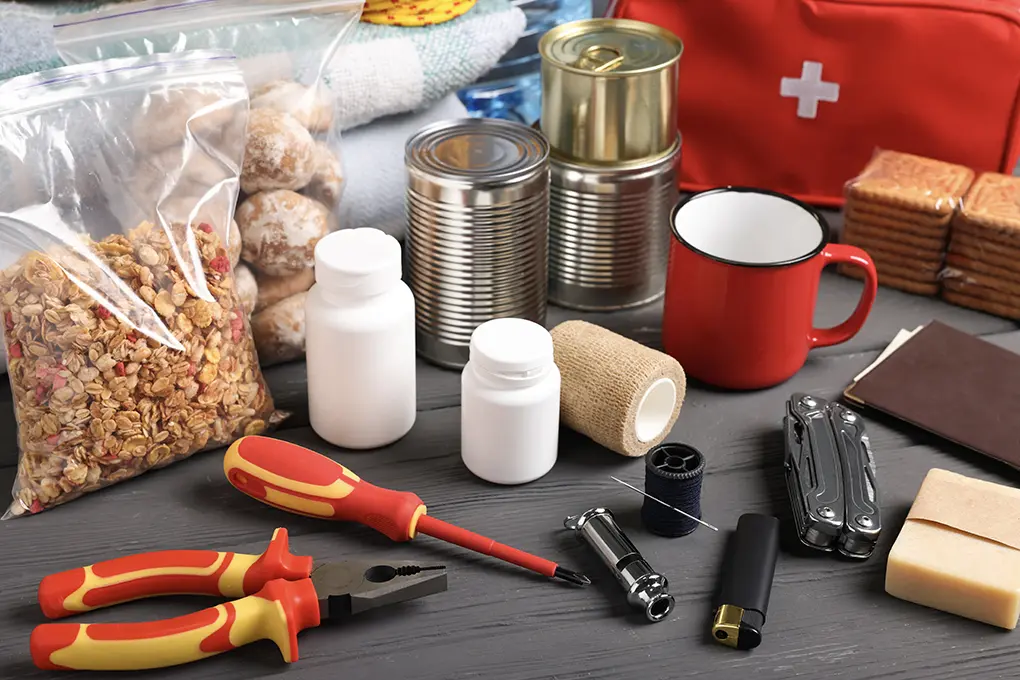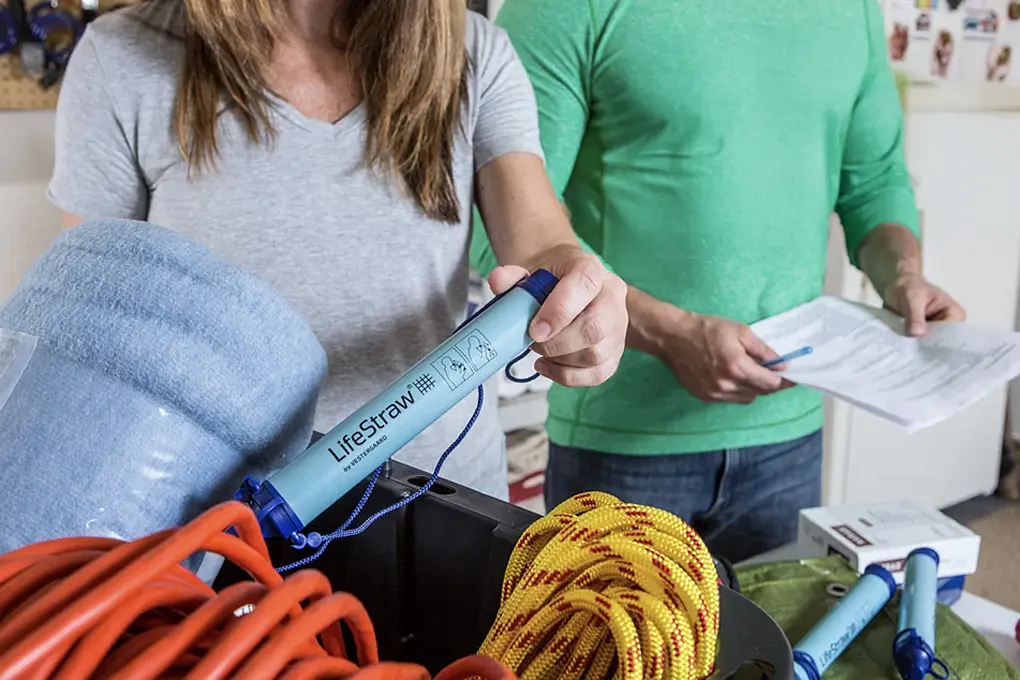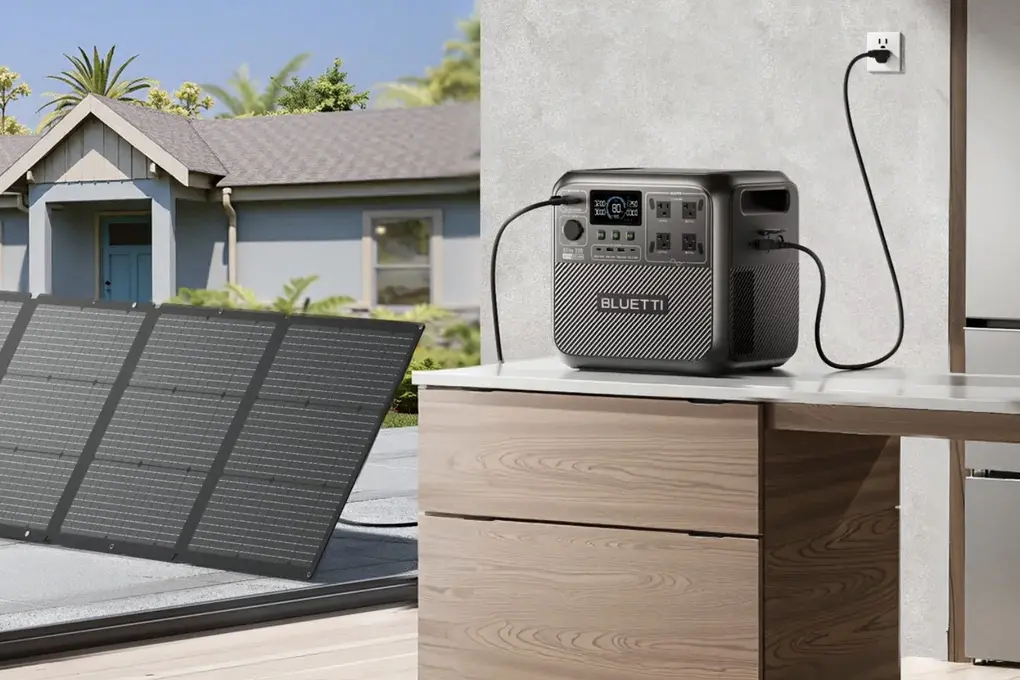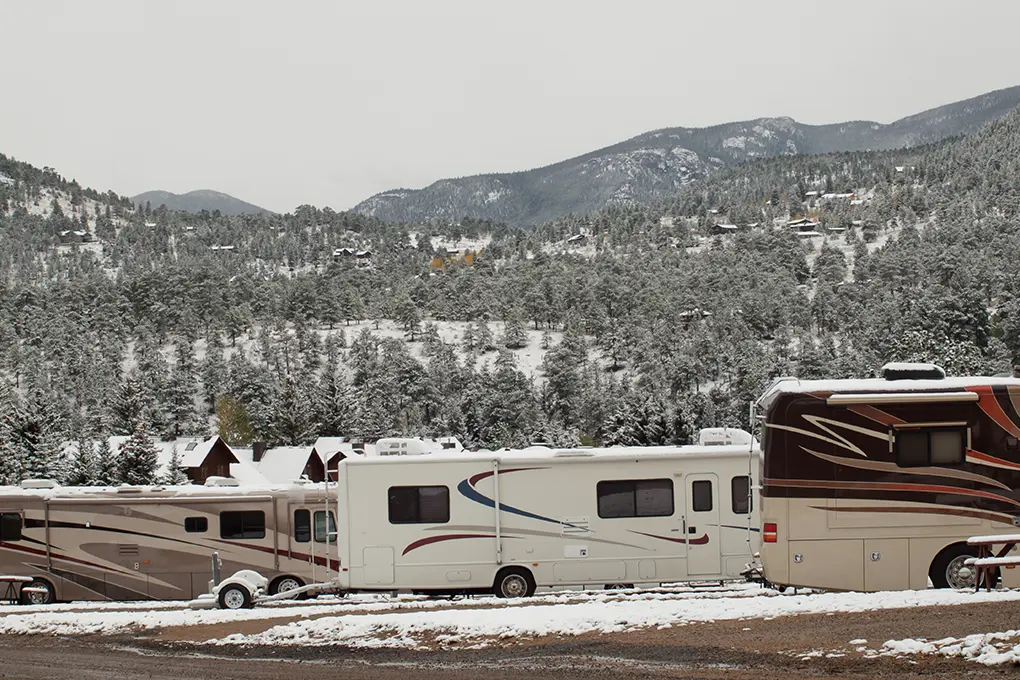I’ve been a prepper for many years now, long before it became a trending topic. What started as a simple desire to be prepared for power outages and snowstorms quickly evolved into a full-on commitment to long-term survival.
Over the years, I’ve built systems, tested gear, and made plenty of mistakes along the way. Today, I want to share everything I’ve learned about advanced prepping so you can take your preparedness to the next level and actually thrive when the grid goes down for good.
Before we get into the strategies, here’s why I believe advanced prepping is more important now than ever:
- In a national survey conducted back in 2020, just over half of Americans said they felt prepared for emergencies, meaning nearly 1 in 2 people don’t have a plan.
- While most households say they have food stored, only around half have enough water to meet basic federal readiness guidelines.
- Roughly 20 million Americans actively prepare for long-term survival scenarios, which means there are still hundreds of millions who aren’t ready to survive beyond a short-term crisis.
- From 2011 through 2024, the U.S. has experienced 14 straight years with at least 10 separate natural disasters causing over a billion dollars in damage. That kind of trend doesn’t suggest we’re in the clear, but rather it suggests we’re just getting started.
- Starting around the mid-2030s, scientists predict that rising sea levels and lunar cycles will combine to cause a full decade of intensified coastal flooding across U.S. cities.
- And if you think that sounds far off, just look back to 2022, when Hurricane Ian knocked out power for more than 2.6 million Floridians, with some left in the dark for weeks.
If you’re relying on a basic bug-out bag or a few gallons of water in the garage, that’s a great start, but it’s not enough. I’m going to guide you through advanced survival prepping so you can survive, adapt, and stay self-sufficient for as long as necessary after a disaster strikes—no matter how long that might be.
Table of Contents
- Key Takeaways
- Long-Term Sustenance: Beyond Your Stockpile
- Water Independence: Systems Beyond Storage
- Energy Resilience: Power When the Grid Fails
- Advanced Medical Preparedness
- Communications Beyond Cell Phones
- Home Security and Defense in Depth
- Community Building and Skill Networks
- Mental and Emotional Resilience
- How I Used These Advanced Prepping Strategies to Prepare for a Disaster
- Putting It All Together: The Advanced Prepper Lifestyle
- How Do You Actually Start Living Like an Advanced Prepper?
- Frequently Asked Questions
Key Takeaways
- Most Americans still don’t meet basic emergency preparedness standards
- Stored food is essential, but sustainable food production matters more
- Rainwater collection and filtration systems are vital for long-term water access
- Off-grid energy systems need solar, battery, and secondary sources like wind or hydro
- Advanced first aid requires both equipment and hands-on medical training
- Communication beyond phones should include HAM, GMRS, and satellite tools
- Community networks and shared skills increase survival odds during long-term crises
Long-Term Sustenance: Beyond Your Stockpile
Storing food is a smart and necessary step in any preparedness plan. However, for true long-term survival, advanced preppers know that relying solely on stored goods is not enough.
Real food security comes from developing sustainable, regenerative food systems that continue to produce regardless of external supply chains.
This section outlines how to move beyond the basics of stockpiling and build long-term food self-sufficiency. We’ll look at survival gardens, small livestock, preservation methods, and more advanced systems like aquaponics and permaculture.
Survival Gardening for Practical Food Production
A well-planned survival garden focuses on growing calorie-dense, nutrient-rich foods that are easy to preserve and can grow reliably in your climate.
Home gardening is increasing drastically in the USA, with emergency preparedness cited as one of the top reasons for starting, along with constantly rushing food costs. Yet, many new gardeners struggle with long-term scalability or yield.
Start Small and Focus on High-Yield Staples
Begin with core crops that provide maximum calories and are easy to store without electricity. These include:
- Potatoes
- Dry beans
- Corn
- Winter squash
- Cabbage
- Beets
These crops offer energy, protein, and long storage potential when dried, cellared, or cured. Focus on what grows well in your USDA plant hardiness zone. For example, in colder regions like Zone 5, root vegetables and legumes often outperform tomatoes or peppers in both yield and reliability.
Expand Seasonally and Track Performance
Use a garden journal to track what varieties work well in your soil and microclimate. Note which crops require extra watering or pest control, and slowly refine your plant selections for maximum return on effort.
Raising Small Livestock for Daily Protein
Incorporating small livestock allows you to produce protein and fertilizer with relatively low input. When managed properly, these animals are efficient, renewable resources.
Chickens
Chickens are a common first step into livestock. A small flock of five laying hens can produce roughly 20 to 25 eggs per week, or over 1,200 per year. They also provide manure for composting and pest control if allowed to free-range part of the day.
- Minimum space: 4 sq. ft. per bird in a coop, plus 8–10 sq. ft. in a run
- Feed options include kitchen scraps, garden waste, and grain mixes
Rabbits
Rabbits are compact, quiet, and fast to reproduce. A breeding trio (one buck and two does) can produce over 100 pounds of meat annually. Their manure is high in nitrogen and can be added directly to gardens without composting.
- Ideal for urban and rural setups
- Minimal odor and maintenance needs
- No refrigeration required for short-term meat storage if processed in intervals
Other options for small livestock include quail, ducks, and even goats for milk if space allows.
Expanding Your Growing Season and Capabilities
Once a basic food system is in place, you can further increase production and resiliency through the following methods:
Seed Saving and Storage
Saving seeds from your best-producing plants ensures long-term planting capability and helps you maintain crop varieties suited to your conditions. Store seeds in airtight containers in a cool, dark place, and rotate every few years to maintain viability.
Greenhouses and Cold Frames
A greenhouse or cold frame allows for year-round growing of cold-tolerant crops like kale, spinach, and carrots. Even in northern climates, these structures extend your growing season by months, increasing yield and food security.
Permaculture and Polyculture Design
Using permaculture principles helps you design systems where plants and animals support each other. Examples include:
- Planting nitrogen-fixing cover crops like clover alongside vegetables
- Incorporating perennials like asparagus, berries, or nut trees
- Designing gardens to reduce water use through natural swales and mulch
Aquaponics Systems
Aquaponics combines fish and hydroponic vegetable production. Fish waste fertilizes the plants, and the plants filter the water. This method allows for compact, high-output systems indoors or in greenhouses.
- Tilapia is a common species due to its fast growth and temperature tolerance
- Leafy greens, herbs, and tomatoes grow well in these systems
Mushroom Cultivation (Mycology)
Growing mushrooms like oyster or shiitake is a great way to produce high-protein food using waste materials such as spent coffee grounds or sawdust. Indoor or shaded outdoor setups require little space and can produce weekly harvests once established.
For short-term food and water supplies, as well as water purification tools, visit the Batten Emergency Marketplace.
Building a Non-Electric Preservation Toolkit
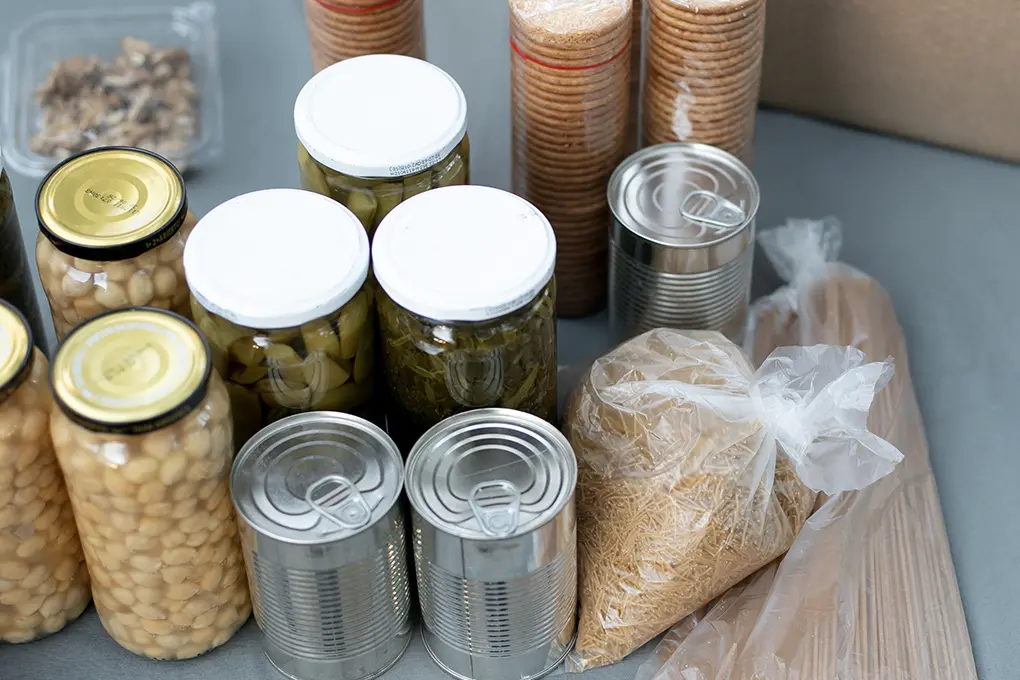
Producing food is just one part of the equation, but preserving it without relying on freezers or refrigeration is equally important. Advanced preppers diversify their preservation skills to adapt to different seasons and energy limitations.
Canning and Pressure Canning
Most preppers are familiar with water bath and pressure canning. While useful, these methods require fuel and equipment, so they’re best supplemented with other options.
Fermentation
Fermenting vegetables like cabbage (sauerkraut), cucumbers (pickles), and even garlic preserves nutrients and introduces gut-friendly probiotics. It’s low-tech and requires only salt, jars, and time.
Dehydration
Sun drying or using a solar dehydrator allows you to preserve fruits, herbs, and vegetables in a lightweight form. Dehydrated food takes up less space and rehydrates easily in soups or stews.
Root Cellaring
Underground or partially buried root cellars can preserve crops like potatoes, carrots, and apples for months without electricity. A basement or shaded crawlspace can also work in colder climates.
Smoking and Salt Curing
These traditional methods are ideal for meat and fish. They extend shelf life by removing moisture and reducing bacteria, making them essential techniques if you’re relying on livestock or game.
Water Independence: Systems Beyond Storage
Most preppers understand the importance of water, but few realize how quickly stored supplies run out. According to the EPA, the average American household uses over 300 gallons of water per day.
Emergency preparedness guidelines suggest storing at least one gallon per person per day for drinking and sanitation. However, even with significant effort, most people can only store a fraction of what is truly needed in a long-term scenario.
True water resilience goes far beyond stockpiling. It requires developing renewable sources, reliable purification methods, and efficient reuse systems. In this section, we’ll walk through the components that make a long-term water plan effective and sustainable.
Rainwater Harvesting for Daily Supply
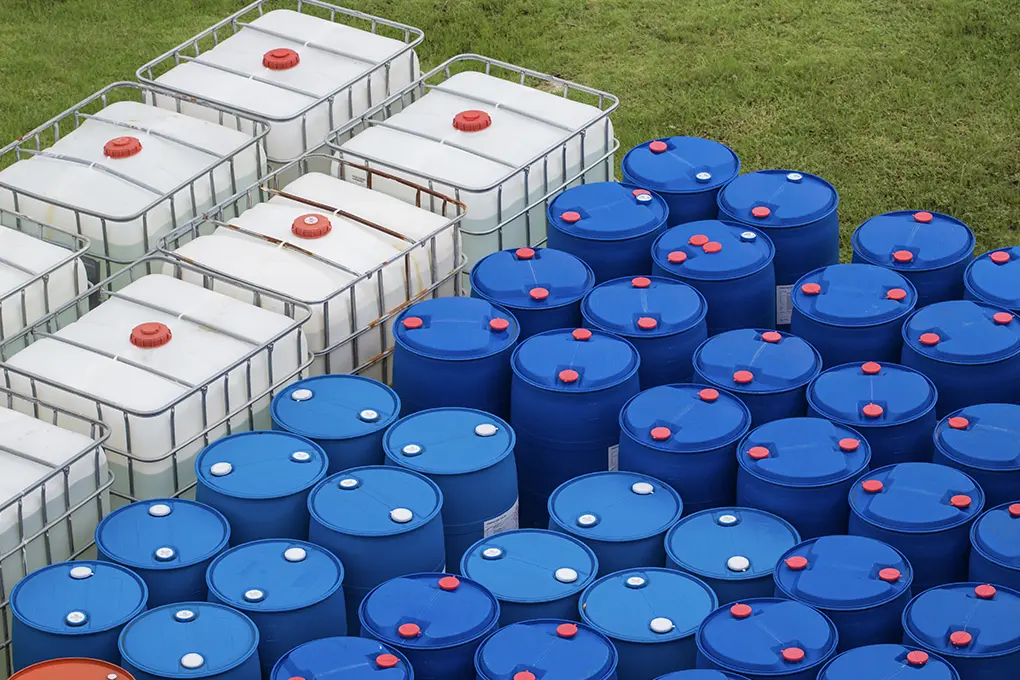
One of the most practical solutions for residential water collection is rainwater harvesting. It is low-cost, scalable, and adaptable to most climates.
For example, a roof measuring 1,000 square feet can collect around 600 gallons of water from just one inch of rainfall. Even in areas with moderate precipitation, this can add up to thousands of gallons annually. The key is designing a system that safely captures, stores, and treats that water.
Core Components of a Rainwater Collection System:
- Catchment Surface: Most often the roof, which should be kept free of debris and toxic materials
- Guttering and Downspouts: Direct water to the storage system efficiently
- First-Flush Diverter: Discards the initial runoff that may contain dirt, bird droppings, and other contaminants
- Storage Tanks: Choose food-grade plastic, concrete, or lined metal tanks in sizes that suit your property and usage
- Filtration Stages: Include a coarse pre-filter for debris, a sediment filter, and a carbon or ceramic filter for finer purification
- Disinfection Options: UV light systems, boiling, or food-safe chlorination to eliminate pathogens
In most climates, with proper storage capacity and system design, rainwater can meet both household and agricultural needs, especially when used efficiently.
Developing Independent Wells
For those living in rural areas or off-grid properties, developing a private well is one of the most reliable ways to secure water. Professionally drilled wells can cost between $5,000 and $15,000 depending on location, depth, and geological conditions. However, in some cases, driven point wells or hand-dug wells are viable for shallow water tables and can be installed for far less.
When developing a well:
- Research your local water table depth and geology
- Test water regularly for contaminants like nitrates, coliform bacteria, and heavy metals
- Install a manual pump or backup power system for electric pumps
Even if you’re relying on municipal water, having a well as a secondary or emergency source adds critical redundancy.
Redundancy and Filtration Systems
In my work with off-grid systems, I’ve seen many people invest in storage and collection while neglecting adequate filtration. Relying on just one method is a mistake. I always recommend building in at least three layers of filtration:
- Mechanical filtration: Such as ceramic or sediment filters to remove particles
- Chemical filtration: Like activated carbon or chlorine for neutralizing contaminants
- Biological or UV treatment: To eliminate viruses and bacteria
Portable options such as Berkey filters, Sawyer systems, and Katadyn filters can supplement larger setups and provide flexibility during mobile scenarios.
Greywater Recycling for Non-Potable Use
Even with access to rainwater or a well, conservation plays a major role. Greywater systems recycle water from showers, bathroom sinks, and laundry machines for use in garden irrigation or flushing toilets. According to The Guardian, this can reduce household water use by up to 50 percent.
While greywater should never be used for drinking, it is perfectly suited for:
- Irrigating fruit trees, shrubs, and ornamentals
- Flushing toilets
- Cleaning tools or equipment
Before implementing a greywater system, check local building codes, and avoid using harsh chemical soaps or cleaners that may harm plants or soil.
Energy Resilience: Power When the Grid Fails
For advanced preppers, energy independence is essential. While portable generators and gas cans may get you through a weekend outage, they fall short in a long-term emergency.
True energy resilience means generating, storing, and managing your own power in a way that functions even when fuel is gone and the grid is down.
This section will outline sustainable power systems, heating strategies, and critical protection measures that go far beyond basic preparedness.
Building a Reliable Solar Power System
Solar energy is the foundation of most off-grid power systems, especially for homes and remote retreats. A well-designed setup can power lighting, refrigeration, communication devices, and even water pumps without relying on external fuel.
Key Solar System Components:
- Solar Panels: Monocrystalline panels provide the best efficiency per square foot and perform well in partial sunlight
- Charge Controllers: Prevent overcharging and manage the flow of energy from the panels to your battery bank
- Battery Storage: Lithium iron phosphate batteries (LiFePO4) are safer, longer-lasting, and more efficient than traditional lead-acid models
- Inverters: Convert stored DC power into AC electricity used by most household devices
- Transfer Switches: Safely switch between grid and off-grid power without risking damage to your home’s electrical system
Many newer systems are designed with modular plug-and-play options for easier installation and portability.
However, one critical detail is often missed: standard grid-tied solar arrays shut down during power outages unless equipped with a battery backup and automatic transfer system. For grid-down reliability, choose a hybrid or off-grid system that can operate independently. Having a reliable power generator is always crucial as well.
Supplementing Solar with Wind and Water
While solar is reliable in most areas, advanced preppers also consider location-specific energy sources to fill in the gaps.
- Wind Turbines: A small turbine (400 to 1,000 watts) can generate power during cloudy or winter months when solar input drops. Wind speeds of at least 10 to 12 mph are needed for consistent output.
- Micro-Hydro Systems: If you have year-round access to flowing water with at least a small vertical drop, micro-hydro can offer continuous power generation—often producing more consistent energy than solar or wind.
Integrating multiple systems provides redundancy and flexibility, especially during changing seasonal conditions.
Efficient Off-Grid Heating Solutions
Heating systems are critical during winter outages. While electric heaters consume too much power for most off-grid setups, wood-based systems offer renewable, reliable heat.
Efficient Wood Heating Options:
- Rocket Mass Heaters: Use less wood while retaining heat in a thermal mass for extended warming
- Masonry Heaters: Burn quickly and cleanly, radiating stored heat over 12–24 hours
- Gasification Wood Boilers: Extract maximum heat from firewood with minimal smoke and ash
Proper firewood management and seasoning are essential. Store at least one full winter’s supply in a dry, covered space, and rotate regularly to avoid moisture buildup or pests.
EMP Protection for Critical Electronics
An often neglected threat is electromagnetic pulse (EMP) damage, which can render sensitive electronics useless. EMPs can result from nuclear events or solar flares, and the effects can disrupt power systems and communication gear.
To reduce risk:
- Use Faraday Cages: These are sealed metal containers that block electromagnetic energy. Metal ammo cans, galvanized trash bins with gasket lids, or specialty EMP bags can protect radios, inverters, charge controllers, and other vital electronics.
- Keep Spares: Backup charge controllers, solar regulators, and radios should be stored separately in protected enclosures.
Test your Faraday setup with a basic radio or Bluetooth device to confirm shielding effectiveness.
Advanced Medical Preparedness
Basic first aid kits can handle minor cuts, scrapes, and temporary discomfort, but they fall short when access to professional care is limited.
Advanced medical preparedness means being equipped and trained to respond to serious injuries, infections, and illnesses when hospitals and clinics are no longer an option.
This level of preparation requires both proper supplies and the knowledge to use them effectively. Below is a breakdown of essential components and practical strategies for building true medical resilience.
Critical Supplies to Have on Hand
Advanced preppers prioritize items that go beyond over-the-counter bandages and antiseptics. These include:
- Trauma Care Tools: Tourniquets, chest seals, pressure dressings, and hemostatic agents like QuikClot or Celox
- Wound Closure Supplies: Sterile sutures, skin staplers, butterfly closures, benzoin tincture, and wound glue
- Immobilization and Support Gear: SAM splints, elastic wraps, and cervical collars for stabilizing fractures and sprains
- Prescription Medications: Acquired legally through medical consultation, these may include antibiotics, epinephrine, antihistamines, and pain relievers
- Diagnostics: Stethoscopes, blood pressure monitors, thermometers, glucometers, and pulse oximeters help track conditions and guide treatment
Having these items is only part of the solution. Knowing how to use them properly is what makes the difference in a true emergency.
Building Your Medical Skill Set
Without training, medical supplies offer limited value. To prepare for off-grid care, advanced preppers invest in hands-on education and ongoing practice.
Recommended Training Options:
- Wilderness First Responder (WFR): Offers practical care techniques in remote or austere conditions
- EMT-Basic Certification: Provides a comprehensive foundation in emergency assessment, stabilization, and transport
- Targeted Skills Courses: Learn suturing, trauma response, field hygiene, and prolonged field care
- Regular Scenario Drills: Practice under realistic conditions to reinforce muscle memory and critical decision-making
Many advanced preppers also connect with healthcare professionals who can offer guidance, training, and advice on legal medication storage. Working with a cooperative physician may allow you to secure a standing supply of essential prescriptions.
The Role of Herbal Medicine
One often overlooked component of preparedness is natural medicine. While not a replacement for conventional care, herbal remedies can be highly useful when access to supplies is limited.
I’ve personally invested time in studying and cultivating a medicinal herb garden tailored to support common needs.
These include:
- Elderberry: Immune system support
- Echinacea: Helpful for respiratory infections
- Comfrey: Traditionally used for bruises and wound healing
- Plantain and Calendula: Effective for skin irritations and minor infections
Knowing how to make tinctures, salves, and teas from these herbs gives you another layer of self-reliance.
That said, for acute medical emergencies, sometimes there’s nothing better than a classic, well-stocked first aid kit.
Communications Beyond Cell Phones
When disasters occur, cellular and internet networks are often the first systems to fail. Power outages, infrastructure damage, or network overload can leave you cut off when you most need to communicate.
That’s why emergency communication planning must go far beyond cell phones. True preparedness involves building alternative systems that can transmit and receive information independently of modern networks.
To structure a reliable emergency communications plan, it’s helpful to understand the core tools available and how to use them effectively.
HAM Radio: The Gold Standard
HAM (amateur) radio is one of the most reliable tools available for emergency communication. With the right license and gear, HAM radio allows you to communicate across town, across provinces, or even globally, depending on your setup and atmospheric conditions. There are three license levels in North America:
- Technician: Grants access to local VHF/UHF frequencies, ideal for short-range and local emergency communications.
- General: Adds privileges for regional and national HF frequencies.
- Extra: Offers full access to all amateur bands with fewer restrictions.
Getting Started With HAM Radio
If you’re new to HAM, these basic steps will help you build a functional setup:
- Obtain at least a Technician license by passing a written exam
- Purchase both a handheld (HT) and a base station transceiver
- Install a quality antenna, which significantly improves range and clarity
- Join a local amateur radio club or emergency network (like ARES or RACES)
- Participate in practice events like ARRL Field Day or weekly radio nets
These activities build familiarity with your gear and give you access to a community of experienced operators.
Complementary Communication Tools
While HAM radio is ideal, redundancy matters. The following tools are useful additions to your communications plan:
- GMRS Radios: Great for local family or neighborhood communication. Requires a simple license but no exam.
- CB Radios: Widely available and license-free. Though limited in range, they’re a solid backup option.
- Satellite Communicators: Devices like the Garmin inReach or ZOLEO let you send SOS alerts or text messages even without cell coverage.
- Radio Scanners: These let you monitor police, fire, and emergency broadcasts to stay informed of developing situations.
- EMP Protection: Keep backup radios and batteries stored in a Faraday cage to protect against electromagnetic pulses that could fry electronics.
Emergency Communication Protocols
Tools alone aren’t enough. Effective emergency communication requires planning and coordination. Your household or group should establish:
- A primary and secondary meeting point
- Specific radio check-in times and frequencies
- Simple codes or phrases for status updates
- A printed contact list with frequencies and call signs
All members should practice using radios under realistic conditions, including during power outages or outdoor excursions.
Home Security and Defense in Depth
Protecting your home effectively means thinking beyond locks and alarms. A strong security strategy uses multiple layers of protection designed to deter, detect, delay, and respond to threats. This layered model, often called defense in depth, builds resilience into every level of your property and response plan.
Securing the Outer Perimeter
The first layer of protection starts outside your home. The goal is to discourage intruders before they even reach the structure.
Smart Perimeter Design
- Landscape Design: Use shrubs, fences, and natural barriers to control access while eliminating hiding spots near windows or doors. Thorny plants under windows can add passive security.
- Motion-Activated Lighting: Install lights that activate with movement around entry points, walkways, and driveways.
- Discreet Deterrents: Use visible security signs and cameras, but avoid showcasing expensive equipment that could attract attention.
- Gate and Driveway Control: Consider gates with intercoms, keypad access, or automatic closure systems to limit entry.
Hardening the Home Structure
Once inside the property line, the focus shifts to reinforcing the home itself. This layer is about physically resisting intrusion and creating safe spaces inside.
Key Structural Defenses
- Entry Point Reinforcements: Install solid-core doors with reinforced frames, deadbolts, and long screws in strike plates.
- Window Protection: Apply security film to windows or use laminated glass to resist forced entry.
- Safe Rooms: Designate a secure interior room with a solid door and communication tools where your family can retreat during an intrusion.
- Escape Routes: Create multiple exit options in case you need to evacuate quickly, such as through basement egress windows or backyard gates.
Internal Protocols and Training
Technology and structure are only part of the equation. Human readiness through planning and practice is a critical layer in home defense.
Family and Community Preparedness
- Security Drills: Conduct regular home security drills so each family member knows where to go and what to do in different emergencies.
- Scenario-Based Planning: Develop specific response plans for situations such as break-ins, fire, or civil unrest.
- Two-Way Radios: Equip family members with radios in case phones fail. Establish check-in times and backup communication methods.
- Legal Defense Readiness: If you choose to incorporate defensive tools, such as pepper spray or firearms, receive proper training and ensure everything complies with local laws.
Building Neighborhood Security Networks
Security improves significantly when communities work together. One of the most practical and effective measures I’ve implemented is collaborating with neighbors to build a basic neighborhood security network.
We’ve set up group chats, agreed on visual signals for emergencies, and informally check in during weather events or power outages. Even small steps like this dramatically increase response capability during prolonged disruptions.
Community Building and Skill Networks
One of the most overlooked aspects of preparedness is the importance of community resilience. While stockpiles and self-reliance are often emphasized, long-term survival is far more dependent on cooperation, shared skills, and mutual support systems. Historically, communities that work together during prolonged crises fare better than individuals acting alone.
Building Local Skill-Based Networks
Advanced preparedness starts by developing strong local connections. These relationships become the foundation for collective problem-solving and resource management when modern systems fail.
How to Build Preparedness-Oriented Networks
- Connect With Like-Minded Individuals: Identify others in your area who are serious about preparedness. Start small with one-on-one conversations, then expand to group discussions.
- Join CERT or Local Emergency Groups: Participating in official programs like Community Emergency Response Teams (CERT) not only provides structured training but also increases your credibility and network reach.
- Create Mutual Aid Agreements: Establish written or verbal agreements with neighbors or local contacts for sharing resources, rotating duties, or providing backup in emergencies.
- Start a Skills Exchange Group: Host regular workshops where members teach each other useful skills such as food preservation, radio operation, or solar power setup.
Practical Skill Sets to Focus On
Knowledge is often more valuable than gear. Skills that improve day-to-day life also form the backbone of resilient communities.
Core Skills That Increase Group Value
- Medical and First Aid Training: Go beyond basic CPR. Learn wound care, infection control, and how to use trauma kits.
- Mechanical and Electrical Repair: Skills in maintaining generators, vehicles, and household systems are in high demand during crises.
- Construction and Carpentry: Building temporary shelters, repairing structures, or reinforcing homes requires practical hands-on ability.
- Wild Food Identification: Learning to safely identify and prepare wild plants can supplement limited food stores.
- Hunting and Processing: Field dressing, preserving, and safely storing meat are vital in prolonged emergencies.
- Radio Communication: Develop both technical know-how and clear protocols for effective group coordination.
- Leadership and Planning: The ability to make decisions, delegate roles, and maintain morale can be a deciding factor in group survival.
In my experience, forming a local skills-sharing group has done more to prepare us for emergencies than stockpiling gear ever did. We meet monthly to share practical lessons and rotate teaching roles. This constant exchange not only builds trust but creates a sense of mutual responsibility that strengthens our overall resilience.
Mental and Emotional Resilience
Preparedness is psychological too. High-stress environments wear down morale, disrupt decision-making, and create group tensions. Therefore, mental preparation is equally important.
Strengthening Psychological Readiness
Advanced preppers adopt habits and training routines that help maintain clarity, composure, and mental endurance during uncertainty.
Key Strategies for Mental Resilience
- Emergency Scenario Drills: Practicing with realistic stressors reduces panic and creates instinctive responses.
- Spiritual or Philosophical Anchors: Whether faith-based or secular, having a personal framework helps individuals process hardship.
- Clear Family Communication Plans: Assign roles, responsibilities, and daily check-ins to keep everyone aligned.
- Accept Slow-Building Crises: Emergencies rarely unfold as sudden disasters. Being mentally prepared for drawn-out disruptions is crucial.
- Stress Management Techniques: Use breathing exercises, journaling, or quiet routines to regulate mental strain without external tools.
Some preppers run weekend “grid-down” trials, including cutting power, phones, and internet,to simulate disruptions. These exercises often reveal weaknesses in both planning and personal tolerance. I’ve found them to be some of the most valuable learning experiences in preparedness.
How I Used These Advanced Prepping Strategies to Prepare for a Disaster
I never set out to live off grid. My original goal was simple: be ready for storms, blackouts, and the occasional supply chain hiccup. But what began with a few cases of water and canned goods in the basement turned into a full lifestyle shift—one built on systems, self-sufficiency, and years of hands-on learning.
Today, I live completely off grid, powered by a solar array supported by a small wind turbine and a backup generator I rarely need. My home is heated with a wood-fired rocket mass heater, and I manage power with a hybrid inverter system and LiFePO4 batteries. It’s more reliable than any city utility I’ve ever depended on.
I grow most of my own food year-round using a mix of raised garden beds, cold frames, and a passive solar greenhouse. Chickens and rabbits supply eggs, meat, and fertilizer, while root crops and canned produce fill the pantry. I’ve integrated permaculture practices and even started experimenting with aquaponics and mushroom cultivation for added variety and resilience.
Water comes from a rain catchment system tied into food-grade tanks, with multi-stage filtration and UV purification. I’ve also developed a shallow well with a manual pump for redundancy. Greywater gets recycled into the garden, and I use fermented compost to feed my soil.
Security is layered: motion lights, reinforced doors, comms radios, and most importantly, neighbors I trust. We hold monthly skill-share workshops and rotate emergency drills. I’m no longer just prepping for disaster, but rather living in a way that insulates me from it.
What I’ve built didn’t happen overnight. It took years of trial, error, and community. But now, whether the grid goes down or not, I’m ready—and I don’t rely on anyone else to keep me safe, fed, or informed.
Putting It All Together: The Advanced Prepper Lifestyle
Advanced preparedness is about developing systems, skills, and relationships that function regardless of external circumstances.
The true measure of advanced preparation is resilience: the ability to adapt to changing conditions while maintaining essential functions.
The journey from basic to advanced prepping involves:
- Evaluating your current preparedness honestly and identifying critical gaps
- Developing sustainable systems rather than just accumulating supplies
- Building skills through both training and regular practice
- Creating redundancies in all critical areas (water, food, energy, security)
- Establishing community networks and mutual aid relationships
- Testing systems regularly through practical exercises
- Continuous learning and adaptation as technologies and circumstances change
Remember that advanced preparation is a marathon, not a sprint. Prioritize developments based on your specific circumstances and most likely scenarios. For most people, investing in reliable water systems and food production capabilities provides the greatest return on investment.
How Do You Actually Start Living Like an Advanced Prepper?
Advanced survival prepping is about building reliable systems that continue to function even when everything else fails.
From renewable food and water sources to off-grid energy, advanced medical readiness, and robust communication tools, each layer you add increases your long-term resilience.
In my own experience, transitioning from basic to advanced prepping took time, consistency, and a willingness to learn by doing. What started as a few emergency supplies turned into a fully self-sustaining lifestyle.
If you’re ready to stop preparing for short outages and start building a way of life that endures any disaster, this is the time to commit.
Ready to elevate your preparedness to the next level? Explore Batten’s curated selection of advanced preparedness equipment or visit our comprehensive resource library for detailed guides on implementing these advanced strategies.
Frequently Asked Questions
How Much Land Do You Need to Be Fully Self-Sufficient?
Most advanced preppers can grow enough food for a small family on ¼ to ½ acre with efficient systems, though more space allows for better diversity and redundancy.
Can I Start Advanced Prepping in an Apartment?
Yes. Start with water filtration, compact food production like sprouting or balcony gardening, and portable power banks. Build community ties and off-site fallback plans.
Is There a Way to Store Medications Long-Term?
Work with a doctor to legally obtain extended prescriptions. Vacuum sealing and cool, dark storage extend shelf life. Antibiotics should be rotated and monitored closely.
What’s the Best First Step Toward Off-Grid Energy?
Start with a small solar generator and battery system to power essentials like lighting, phones, and radios. Expand with experience and based on your usage needs.
How Can I Practice Preparedness Without Causing Burnout?
Run monthly system tests or 48-hour grid-down drills. Rotate tasks with family or preparedness groups to share the load and keep morale high.
Sources
- Comparison of Emergency Preparedness Practices between Food Assistance Program Participants and Non-Participants in the United States – PMC
- Household Food and Water Emergency Preparedness Practices Across the United States | Disaster Medicine and Public Health Preparedness | Cambridge Core
- Always prepared: why prepping for doomsday is a logical choice for many Americans | Society | The Guardian
- 2024: An active year of U.S. billion-dollar weather and climate disasters | NOAA Climate.gov
- Study Projects a Surge in Coastal Flooding, Starting in 2030s – Climate Change: Vital Signs of the Planet
- U.S. electricity customers averaged seven hours of power interruptions in 2021 – U.S. Energy Information Administration (EIA)
- More people growing food at home, grocery costs remain high
- Living Without a Refrigerator – 5 Easy Ways to Preserve Food Without Electricity – Modern Homesteading | Stylish Self-Sufficient Living | Homesteading | City to Country | City and Country Life | Homesteading Blog | Moving to the Country Blog | How to Homestead
- How We Use Water | US EPA
- Off-Grid Water Filtration System – Water & Wastewater
- Greywater systems: can they really reduce your bills? | Live Better | The Guardian
- The Best Options for Off Grid Communication
- Security | IBM
- Community Emergency Response Team (CERT) | FEMA.gov
